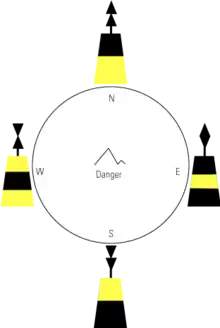Day beacon
A day beacon (sometimes "daybeacon") is an unlighted nautical sea mark. A signboard attached to a day beacon is called a day mark and is used to identify it.[1] Typically, day beacons mark channels whose key points are marked by lighted buoys. Day beacons may also mark smaller navigable routes in their entirety. They are the most common aid to nautical navigation in shallow water as they are relatively inexpensive to install and maintain. Navigation around day beacons is the same as with all other navigational aids.
Identification
Lateral marking
For historical reasons, there are two systems for lateral day beacons. When proceeding from open water towards harbor, marks with cylindrical topmarks or square dayboards are kept to port in both regions, but colors and numbers are reversed.
| IALA Region | Area covered, very roughly | Colors when approaching harbors from seaward | Numbers | Shape |
|---|---|---|---|---|
| Region A | Europe, Africa, most of Asia, Australia | Lefthand side marks are red Right: green |
Left: even numbers Right: odd numbers |
Left: cylindrical topmarks, square dayboards, can buoys Right: conical topmarks, triangular dayboards, nun buoys |
| Region B | N&S America, Japan, Philippines, Eastern Pacific | Left: green Right: red |
Left: odd Right: even |
The same |
When lateral beacons are paired, vessels should pass between the pairing. However, beacons are also frequently placed individually. Generally, single lateral beacons are at the inside corner of a turn. Interior or exterior placement can be determined based upon the passing side (port or starboard) dictated by beacon designation. However, a current chart should always be consulted for all but the shallowest-draft vessels, as channel conditions are rarely ideal.
Cardinal marking

Cardinal day beacons are used to indicate the position of a hazard and the direction of safe water as a cardinal direction (north, east, south or west) relative to the mark. This makes them meaningful regardless of the direction or position of the approaching vessel, in contrast to the lateral mark system.
A cardinal day beacon indicates one of the four compass directions by:[3]
- the direction of its two conical top-marks, which can both point up, indicating north; down, indicating south; towards each other, indicating west; or away from each other, indicating east
- its distinctive pattern of black and yellow stripes, which follows the orientation of the cones – the black stripe is in the position pointed to by the cones (e.g. at the top for a north cardinal, in the middle for a west cardinal)
See also
References
- "Nautical Terms Glossary". National Marine Institute, Inc. Archived from the original on 2003-12-17. Retrieved 2016-12-29.
- Chart No. 1, Section IQ: Buoys, Beacons. Jointly by NOAA and Department of Commerce, USA. The cited book incorporates International Hydrographic Organization Chart INT 1 and therefore represents the practice of the member states.
- "Cardinal Marks" (PDF). IALA. Archived from the original (PDF) on 2007-12-14.